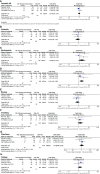A Comparison of Bevacizumab Plus TAS-102 and TAS-102 Monotherapy for Metastatic Colorectal Cancer: A Systematic Review and Meta-Analysis
- PMID: 34868908
- PMCID: PMC8637322
- DOI: 10.3389/fonc.2021.690515
A Comparison of Bevacizumab Plus TAS-102 and TAS-102 Monotherapy for Metastatic Colorectal Cancer: A Systematic Review and Meta-Analysis
Abstract
Backgrounds: As a new oral chemotherapy drug, TAS-102 is currently recommended as the third-line treatment for metastatic colorectal cancer (mCRC). Recently, studies have reported the efficacy of TAS-102 combined with bevacizumab in colon cancer patients after standard treatment fails. Here, we evaluated the efficacy and safety of TAS-102 combined with bevacizumab versus TAS-102 as a single agent by a systematic review and a meta-analysis.
Methods: PubMed, Web of Science and Cochrane libraries were searched. Studies involving bevacizumab combined with TAS-102 in mCRC were included. Study characteristics (author, year of publication, country et al.), efficacy (disease control rate(DCR), progression-free survival(PFS), overall survival(OS)) and adverse effects were extract from studies. Forest plots were created based on Cox model analysis.
Results: After screening 550 studies, a total of 3 studies were included, which compared the safety and effectiveness of TAS-102 with or without bevacizumab. Analysis based on Cox regression showed that the combined treatment group had advantages in 6-month (OR= 2.93, 95% CI: 1.72 to 5.00, P<0.0001), 12-month(OR= 2.18, 95% CI: 1.24 to 3.81, P=0.006), and 18-month (OR=3.08, 95% CI: 1.34 to 7.12, P=0.008) OS. The combined treatment group demonstrated superiority in 6-month PFS rates (OR= 2.50, 95% CI: 1.18 to 5.31, P=0.02). The incidence of thrombocytopenia in the dual-drug treatment group was higher (OR= 1.96, 95% CI: 1.14 to 3.36 P=0.01). The proportion of serious adverse events were similar in tow groups (OR= 1.01, 95% CI: 0.76 to 1.34 P=0.93).
Conclusion: Bevacizumab combined with TAS-102 could improve the prognosis of patients with mCRC who have failed standard treatment. In terms of side effects, the addition of bevacizumab did not increase serious adverse reactions, but the occurrence of thrombocytopenia was worth noting.
Keywords: TAS-102; bevacizumab; colorectal cancer; meta-analysis 3; survival.
Copyright © 2021 Chen, Qiu, Chen, Wang, Zhu, Pan, Deng, Yang and Chen.
Conflict of interest statement
The authors declare that the research was conducted in the absence of any commercial or financial relationships that could be construed as a potential conflict of interest.
Figures






Similar articles
-
Comparison of the efficacy and safety of third-line treatments for metastatic colorectal cancer: a systematic review and network meta-analysis.Front Oncol. 2023 Sep 21;13:1269203. doi: 10.3389/fonc.2023.1269203. eCollection 2023. Front Oncol. 2023. PMID: 37810981 Free PMC article.
-
Combination chemotherapy with TAS-102 plus bevacizumab in salvage-line treatment of metastatic colorectal cancer: A single-center, retrospective study examining the prognostic value of the modified Glasgow Prognostic Score in salvage-line therapy of metastatic colorectal cancer.Mol Clin Oncol. 2019 Oct;11(4):390-396. doi: 10.3892/mco.2019.1899. Epub 2019 Jul 18. Mol Clin Oncol. 2019. PMID: 31475067 Free PMC article.
-
TAS-102 with or without bevacizumab in patients with chemorefractory metastatic colorectal cancer: an investigator-initiated, open-label, randomised, phase 2 trial.Lancet Oncol. 2020 Mar;21(3):412-420. doi: 10.1016/S1470-2045(19)30827-7. Epub 2020 Jan 27. Lancet Oncol. 2020. PMID: 31999946 Clinical Trial.
-
TAS-102 (trifluridine/tipiracil) plus bevacizumab versus TAS-102 alone as salvage treatment options for metastatic colorectal cancer in routine clinical practice.Front Oncol. 2024 Sep 30;14:1450732. doi: 10.3389/fonc.2024.1450732. eCollection 2024. Front Oncol. 2024. PMID: 39403341 Free PMC article.
-
TAS-102 Monotherapy and Combination Therapy with Bevacizumab for Metastatic Colorectal Cancer.Gastroenterol Res Pract. 2021 Dec 20;2021:4014601. doi: 10.1155/2021/4014601. eCollection 2021. Gastroenterol Res Pract. 2021. PMID: 34966426 Free PMC article. Review.
Cited by
-
Anticancer effects of PEP06 (TB01) in combination with Trifluridine/Tipiracil (TAS-102) in a xenograft model of human colorectal cancer.J Cancer Res Clin Oncol. 2024 Dec 26;151(1):22. doi: 10.1007/s00432-024-05984-z. J Cancer Res Clin Oncol. 2024. PMID: 39724415 Free PMC article.
-
<em>miR-19a</em> targeting <em>CLCA4</em> to regulate the proliferation, migration, and invasion of colorectal cancer cells.Eur J Histochem. 2022 Mar 10;66(1):3381. doi: 10.4081/ejh.2022.3381. Eur J Histochem. 2022. PMID: 35266369 Free PMC article.
-
RETRO-TAS, a Retrospective Observational Study of Trifluridine/Tipiracil in Chemorefractory Metastatic Colorectal Cancer.Biomedicines. 2023 Apr 24;11(5):1267. doi: 10.3390/biomedicines11051267. Biomedicines. 2023. PMID: 37238938 Free PMC article.
-
Effects and risk factors of TAS-102 in real-world patients with metastatic colorectal cancer, EROTAS-R study.Int J Clin Oncol. 2023 Oct;28(10):1378-1387. doi: 10.1007/s10147-023-02389-9. Epub 2023 Aug 14. Int J Clin Oncol. 2023. PMID: 37578664
-
Clinical effect and safety of targeted therapy combined with chemotherapy in the treatment of patients with advanced colon cancer.Pak J Med Sci. 2023 Jul-Aug;39(4):1074-1079. doi: 10.12669/pjms.39.4.7105. Pak J Med Sci. 2023. PMID: 37492316 Free PMC article.
References
-
- Kim ST, Kang JH, Lee J, Lee HW, Oh SY, Jang JS, et al. . Capecitabine Plus Oxaliplatin Versus Gemcitabine Plus Oxaliplatin as First-Line Therapy for Advanced Biliary Tract Cancers: A Multicenter, Open-Label, Randomized, Phase III, Noninferiority Trial. Ann Oncol (2019) 30(5):788–95. doi: 10.1093/annonc/mdz058 - DOI - PubMed
Publication types
LinkOut - more resources
Full Text Sources
Research Materials

